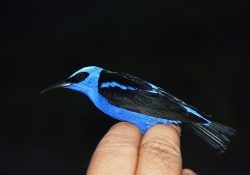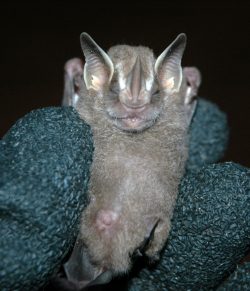The rain forest has a particular attraction and nothing prepares you for the sounds and sights you encounter. The senses are bombarded day and night and in the first few days until one acclimatises to the surroundings, hardly any work can be expected to be done.
Once settled and the senses start to pick up tiny movements on the ground or faint sounds coming from the thick branches, it is time for work. The fauna here is so diverse and to say that it is different from ours is an understatement. One finds hummingbirds as tiny as a small bee, beetles as large as sparrows. Snakes can be seen slithering on the ground or hanging from a branch looking directly into your eyes. The entomofauna is as wonderful as it is bizarre. The Lepidoptera is spectacular with butterflies and moths of all sizes can be seen darting in and out of the forests while beetles ranging from tiny species to the largest known beetle, live on dead animals, branches and foliage. Crickets are numerous especially at night, as are species from many other different groups. Mammals, due to their nocturnal habits are rather difficult to encounter. A Leopard was seen once, Common Possoms frequently fall victim to cars as do Nine-banded Armadillos. Agouti, Pacas and the largest known rodent, the Capybara can be occasionally seen in the forests or river edges. There are also primates in the forest and one can encounter tiny Squirrel Monkeys and Golden-pawed Tamarinds jumping and running on the branches above you. While watching and trying to identify all these species by sight can be quite overwhelming, this challenge is increased tenfold when you try to identify the sounds coming from all around you. Insects calling like birds, birds calling like frogs, frogs calling like insects and so on.
I had the privilege of visiting French Guiana on four occasions; 2011, 2012, 2014 and very recently in January-February of 2017. Each time the team was mainly composed of entomologists with particular interest in the Lepidoptera, especially the nocturnal moths. Of the several hundreds of species of moths collected by our team, a small number were un-described, that is, new to science. Of these newly described moths include: Strophocerus flavus Thiaucourt and Marthula sammuti Thiaucourt the latter named for the Maltese Lepidopterologist Paul Sammut. Ecdemus roseijugalis Cerda and Heliura roseiventris Cerda and Plusiadonta lucasammuti Lalanne-Cassou & Barbut. Many other species are awaiting description. Apart from the large variety of moths, other voucher species were collected, mainly Coleoptera (beetles) and Orthopera (Crickets and Grasshoppers).
There are almost 20 ornithologists in French Guiana, in a territory of approximately 84,000km2, so records from visiting ornithologist and birders are more than welcomed. Records of all sightings are sent to the Rarities Committee (Comité d’Homologation de Guyane) and to the active bird conservation organization, the Groupe d’Étude et de Protection des Oiseaux en Guyane (GEPOG). The current bird list of French Guiana has 701 species (www.gepog.org/index_en.html), this includes one endemic, Cayenne Nightjar Caprimulgus maculosus. Classified as Data Deficient by BirdLife International, this nightjar is known only from the type-specimen, a male collected at Saut Tamanoir on the Fleuve Mana in 1917.
Much of the time spent in French Guiana was along the coastal belt which covers diverse habitats ranging from mudflats and sandy beaches, mangroves, savannahs to primary and secondary forests. So while one can watch waders and gulls in the morning, by early afternoon one can drive inland and watch out for tanagers, hummingbirds, parrots, cotingas and other forest species. Raptors, especially Black and Turkey Vultures can be seen all over while Lesser and Greater Yellow-faced and King Vultures are more localized. Along the road one can regularly see Roadside Hawks, Yellow-faced Caracaras and other raptors. Handling the first Reddish Hermit, one of the smallest hummingbirds was an unforgettable experience as where the different species of nightjars, tanagers and others. The occasional visits to the coastline, usually as a break from forest work, were always fruitful with hundreds of migrating waders, Black Skimmers, gulls and terns recorded.
All the information collected during our visits is being utilised by the French organisations in collating and maintaining a database on the fauna of French Giuana for future conservation projects. Looking forward for future field work opportunities.
By John J Borg, Senior Curator Natural History Unit at Heritage Malta and ex BirdLife Malta Council Secretary


